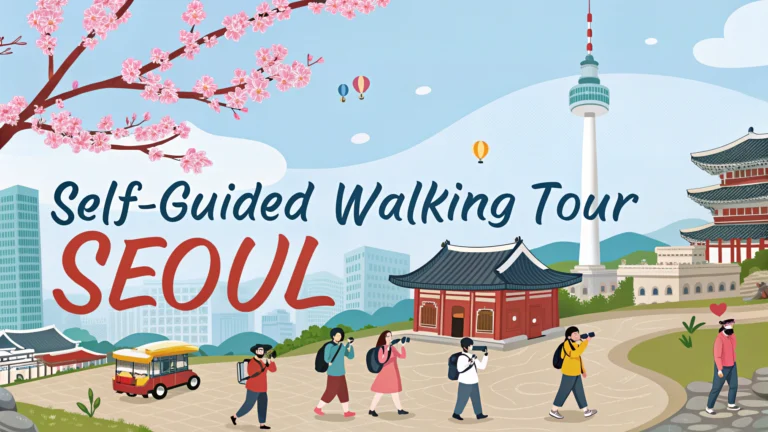Seoul’s rich history, modern culture, and diverse neighborhoods make it perfect for self-guided walking tours.
Essential Walking Routes
Bukchon Hanok Village Route (2-3 hours)
- Start: Anguk Station (Line 3, Exit 2)
- Key stops: Traditional hanok houses, Bukchon Traditional Culture Center, Gahoe-dong Street
- End: Samcheongdong-gil Road
Insadong Cultural Walk (1-2 hours)
- Start: Anguk Station (Line 3, Exit 6)
- Key stops: Ssamziegil Mall, traditional tea houses, art galleries
- End: Jogyesa Temple
Cheonggyecheon Stream Walk (2 hours)
- Start: Gwanghwamun Station (Line 5, Exit 5)
- Key stops: Cheonggyecheon Plaza, various art installations
- End: Dongdaemun Design Plaza
Tips for Walking Tours
- Best times: Spring (March-May) and Fall (September-November)
- Wear: Comfortable walking shoes and weather-appropriate clothing
- Bring: Water bottle, snacks, T-money card for public transport
Navigation Tools
- Naver Maps – Most accurate for Korea (available in English)
- KakaoMap – Popular local alternative
- Seoul Metro App – For subway navigation
Safety Information
Seoul ranks among the safest cities for solo travelers and walking tours.
Police stations are marked with 경찰서 (Gyeongchalso) signs.
Emergency number: 112 (Police), 119 (Ambulance/Fire)
Food Stops
- Insadong: Traditional tea houses and Korean restaurants
- Bukchon: Cafes with traditional rice cakes and tea
- Cheonggyecheon: Street food stalls and local eateries
Rest Points
- Public restrooms available at subway stations
- Convenience stores (GS25, CU, 7-Eleven) offer restrooms and refreshments
- Traditional tea houses provide peaceful breaks
Tourist Information Centers are located at major subway stations: Seoul Station, Hongik University Station, and Myeongdong Station.
Free guided walking tours are available through the Seoul Tourism Organization (http://english.visitseoul.net).
Download offline maps before your tour as backup navigation.
Additional Routes
Hongdae Art Walk (2-3 hours)
- Start: Hongik University Station (Line 2, Exit 9)
- Key stops: Street art murals, indie music venues, Hongdae Playground
- End: KT&G Sangsangmadang
Dongdaemun Night Walk (2 hours)
- Start: Dongdaemun History & Culture Park Station (Line 2,4,5)
- Key stops: Night markets, fashion malls, LED rose garden
- End: Dongdaemun Design Plaza rooftop
Seasonal Considerations
- Summer: Start early morning or evening to avoid heat
- Winter: Indoor route alternatives available
- Monsoon season: Carry umbrella and waterproof gear
Photography Spots
- Bukchon: Observatory deck, hanok rooftops
- Cheonggyecheon: Light installations, seasonal decorations
- Insadong: Traditional craftwork, street performances
Conclusion
Seoul’s walking tours offer an intimate way to explore the city’s contrast of traditional and modern elements. Each route provides unique perspectives of Korean culture, architecture, and urban life. Planning with these resources ensures a rewarding self-guided experience through Seoul’s diverse districts.
Consider joining local walking groups or checking seasonal festivals that might coincide with your route for an enhanced experience.
FAQs
- What are the best areas in Seoul for self-guided walking tours?
The most popular areas are Bukchon Hanok Village, Insadong, Myeongdong, Hongdae, and Gwanghwamun. These districts offer a mix of traditional and modern Seoul with well-marked walking paths and plenty of attractions. - How long should I plan for a self-guided walking tour in Seoul?
Most neighborhood walking tours take 2-4 hours to complete. Major areas like Bukchon or Insadong require about 3 hours to explore thoroughly, while combining multiple districts could take a full day. - Do I need to download any apps for self-guided tours in Seoul?
Having Naver Maps or Kakao Maps is essential as Google Maps isn’t reliable in Seoul. The Visit Seoul app is also helpful as it provides offline walking tour routes and cultural information. - Is it safe to do self-guided walking tours in Seoul?
Seoul is one of the safest major cities in the world for walking tours. The city has low crime rates, well-lit streets, and extensive CCTV coverage. Walking alone even at night is generally safe. - What’s the best time of year for walking tours in Seoul?
Spring (March-May) and Fall (September-November) offer the most pleasant weather for walking tours. Cherry blossom season in April and autumn foliage in October are particularly popular times. - Should I book any tickets in advance for attractions along walking routes?
While most streets and traditional areas are free to explore, some palaces like Gyeongbokgung require tickets. These can be purchased on-site, but booking in advance is recommended during peak tourist seasons. - What should I bring on a self-guided walking tour in Seoul?
Essential items include comfortable walking shoes, a refillable water bottle, T-money card for public transport, portable wifi or local SIM card, and a fully charged phone for navigation. - Are English signs available along walking routes in Seoul?
Major tourist areas have signs in English, Korean, Japanese, and Chinese. However, in less touristy areas, English signage might be limited, so having a navigation app is recommended. - Can I combine public transportation with walking tours?
Yes, Seoul’s extensive subway and bus system makes it easy to combine walking tours with public transport. Major walking routes are typically connected to subway stations, making it convenient to explore multiple areas. - Where can I find public restrooms during walking tours?
Public restrooms are readily available in subway stations, department stores, and major tourist attractions. Most cafes and restaurants also allow customers to use their facilities.








